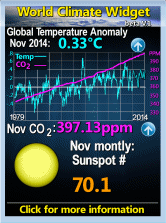The U.S. dollar is acting like a sentiment indicator, in addition to being a rather obvious method of making assets seem to gain value. Of course we know it's asset inflation fueled by a deflating dollar. For quite awhile, the weakening dollar has been a proxy for complacent sentiment as the volatility index (measured by $VIX among other instruments) has also descended. When the stock markets made new recovery highs recently, that was marked by both the dollar and $VIX breaking prior swing-low support. As often happens, the immediate reaction was a step back in the other direction - in this case, upward in dollar and $VIX as stock markets staggered last week. But both the dollar and $VIX are now testing resistance - so what's next?
Tony Caldaro (of the Elliott Wave Lives On site featured at right here) and others have mentioned 71.31 as the big prior low in $USD, the line that will be crossed if the dollar collapses. On my weekly chart of the dollar index below, the absolute low is 70.70 (an interesting Fibonacci number in its own right). If it breaks 71.31 then we may expect 70.70 to give way too. If it happens, this may cause an adverse reaction such that the $VIX might break away into an inverse relationship ($VIX up with $USD collapse). If the dollar is thrusting downward from a standard triangle on the monthly chart, also below, the measured-move target would be 66 in $USD.
Is 66 $USD really likely? I've got my doubts. It would be accompanied by the euro rising above 151.44 in $XEU ($FXE as the euro index ETF). Sure, these extremes can theoretically occur. I think it's more likely that the dollar will trace a bottoming pattern - including going lower but not breaking 70.70 - with the euro tracing a top without making 151.44 $XEU into support. Translating into the stock market continuing higher, then topping. The stock market top could be Tony Caldaro's big first wave, or if it happens at/before June then a bearish alternative count would be a B wave (since June is the 1.618 time extension of the 17-month drop from 2007 into 2009; the February highs occurred at the 1.318 time extension). A stock market high after June should negate the potential of such a bearish B wave - we'll see.
As for the dollar - a drop under 71.31 (70.70) could cause a bearish stock market reaction, but stocks would also drop if the dollar strengthened dramatically. Sure, there've been years in the past when the dollar went up along with stocks, but we can't simply say that's going to start happening again now or at a specific time in the future. My theory is that it will happen again. Whenever it does - a riding dollar along with rising U.S. stock indices - it certainly will mark a very bullish time for the U.S. economy and its stocks. We just cannot have certainty that the time is ripe for that yet; could take months or even years.
This places equities in a Scylla and Charybdis (the Greek legendary sailor's danger zone), "between a rock and a hard place" position. Assets like stocks and commodities can continue to get support from the dollar dropping some more. But if it threatens to cross the big lines of 71.31 (70.70) $USD / 151.44 $XEU, then market reaction may roil the markets much more than what we just saw last week. So it seems that dancing closer to the door makes more sense now as the sweet music may be coming to an end either way. We'll see if that time frame is June, or if it can last into the fall or into early 2012.
And here are the $VIX charts. The time scale isn't exactly the same yet you can see the movement has paralleled the dollar. $VIX dropped under support of prior swing low (weekly chart at bottom), then swung up and tested resistance (easier to see on daily, first chart below). Those interested in using the volatility index as an indicator will also want follow the work of Bill Luby who's tweeted as @VixandMore of his VixandMore site; and, to see these articles about the $VIX, published May 3 and 4: The Market Message from the Volatility Index (VIX) ... | Marty Chenard | Safehaven.com and Part II: The Market Message from the Volatility Index (VIX) ... | Marty Chenard | Safehaven.com.
Sunday, May 8, 2011
The dollar as proxy for volatility, testing resistance may weaken more without collapsing
Labels:
Equities,
Euro,
Others on the Web,
US Dollar,
VIX,
Year 2011 Overview
Subscribe to:
Post Comments (Atom)










No comments:
Post a Comment